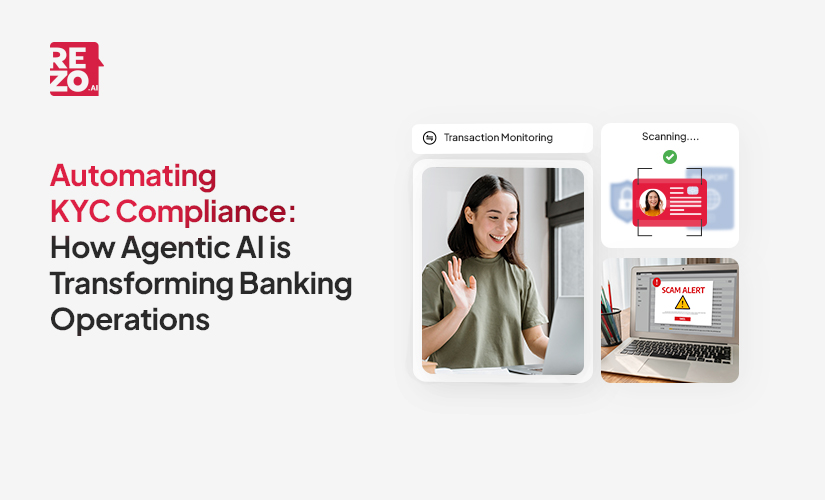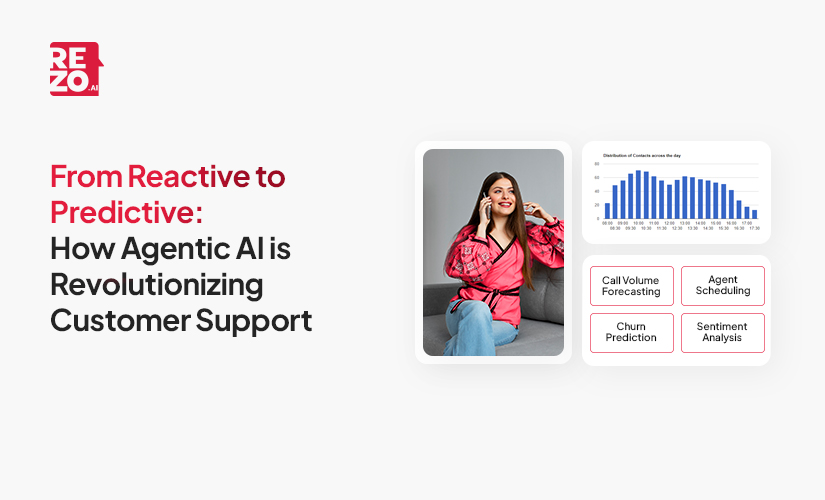
CX Leader's Guide to Agentic AI

CX Leader's Guide to Agentic AI


Agentic AI is already changing the customer experience landscape. Unlike automation or even generative AI, Agentic AI is an autonomous, goal-driven agent that makes decisions, takes action and learns from every interaction with minimal human intervention. For CX leaders this is a big opportunity to solve the persistent problems of fragmented customer journeys, agent burnout and data overload.
This guide will give you a clear, actionable plan to integrate agentic AI into the strategy. It will outline the problems agentic AI can solve, the steps to successful adoption and the measurable results. If you want to drive efficiency, personalization and proactivity in your CX operations, Agentic AI is the next step.
Solving for Legacy Systems Challenges
Legacy systems were designed for stability not agility and have become barriers to efficiency as business needs change. Common challenges include outdated architecture, lack of documentation, integration complexity, cybersecurity vulnerabilities and slow project timelines, all of which can stall digital transformation and degrade customer experience.
Traditional modernization approaches force CX leaders into a dilemma: either do costly, high risk system replacements or apply incremental patches that rarely address the root causes of inefficiency. The result is a disjointed, slow experience for customers and employees with data scattered across multiple platforms and manual processes draining productivity.
Agentic AI provides a fundamentally different solution. AI agents can dynamically generate APIs that translate legacy protocols (like SOAP or FTP) into modern standards (REST, JSON), enabling real-time data exchange between old and new platforms without extensive redevelopment. Using advanced, context-aware ETL pipelines, Agentic AI reconciles mismatched data schemas and formats, transforming siloed, fixed-structure data into unified, actionable information for CX teams.
For CX leaders, this means legacy systems no longer have to be a barrier. Agentic AI enables businesses to modernize customer experience, improve agility and unlock new efficiencies without abandoning the investments that underpin daily operations.
Traditional personalization tools in CX rely heavily on static segmentation and periodic batch processing, which limits their ability to respond to real-time customer behavior and context. These systems often struggle with fragmented data sources, outdated customer profiles, and a lack of situational awareness, resulting in generic interactions that fail to engage customers on an individual level.
Hyper-personalization at Scale
Hyper-personalization at scale has always been a challenge for large enterprises aiming to increase customer satisfaction and customer loyalty. Traditional systems often rely on broad customer segments and outdated data, which means most customers end up getting generic messages and offers throughout their customer journey. These tools simply can’t keep up especially when data is scattered across different business process systems and channels.
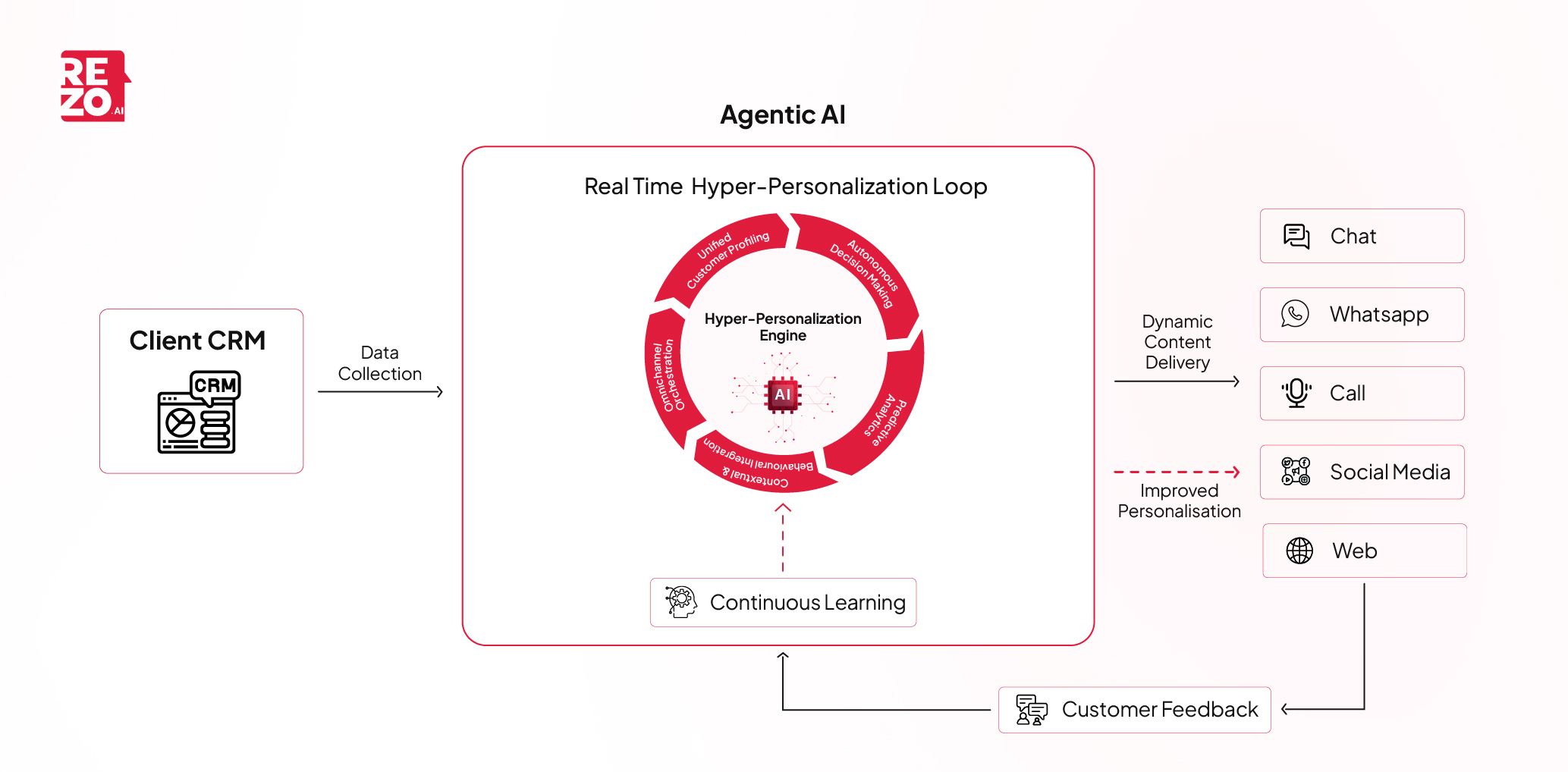
Agentic AI changes the game by bringing all your customer data whether it’s from your CRM, website, mobile app, or even legacy systems into one place and making sense of it in real time. Instead of waiting for weekly or monthly updates, Agentic AI updates customer profiles instantly, picking up on small signals like a customer’s location, device, recent purchases, or even the customer sentiment during a support call. This means your business can respond with the right message, offer, or support at exactly the right moment, significantly enhancing customer experience.
What really sets Agentic AI apart is its ability to learn and adapt on its own, much like the latest generative AI models. It doesn’t just follow pre-set rules, it tests different messages and offers, sees what works best for each customer, and keeps improving automatically based on real customer feedback.
For CX leaders, this means you can finally deliver true one-to-one personalization, not just for a few high-value customers but for millions at once. You don’t need massive manual effort or complicated campaign management. With the right data pipelines and AI powered agents in place, your team can focus on strategy while the system handles the heavy lifting, constantly learning, adapting, and delivering better results. The end result is happier customers, higher conversion rates, and a customer experience strategy that’s truly ready for the future.
Turn Data Overload Chaos into a Strategic Advantage
Data overload is one of the biggest headaches for CX leaders in large enterprises today. Every day, your business collects massive amounts of information from customer calls, emails, social media, website visits, mobile apps, and even old legacy systems. The problem isn’t a lack of data, it’s that there’s simply too much, coming in from too many places, and in too many different formats. This makes it nearly impossible for teams to quickly find what really matters, leading to slow decision-making and missed opportunities to delight customers.
Agentic AI addresses this by deploying autonomous, multi-agent systems that automate the entire data lifecycle. These AI agents collaborate to ingest, clean, structure, and analyze petabytes of data in real time, using context-aware reasoning to prioritize high-impact insights.
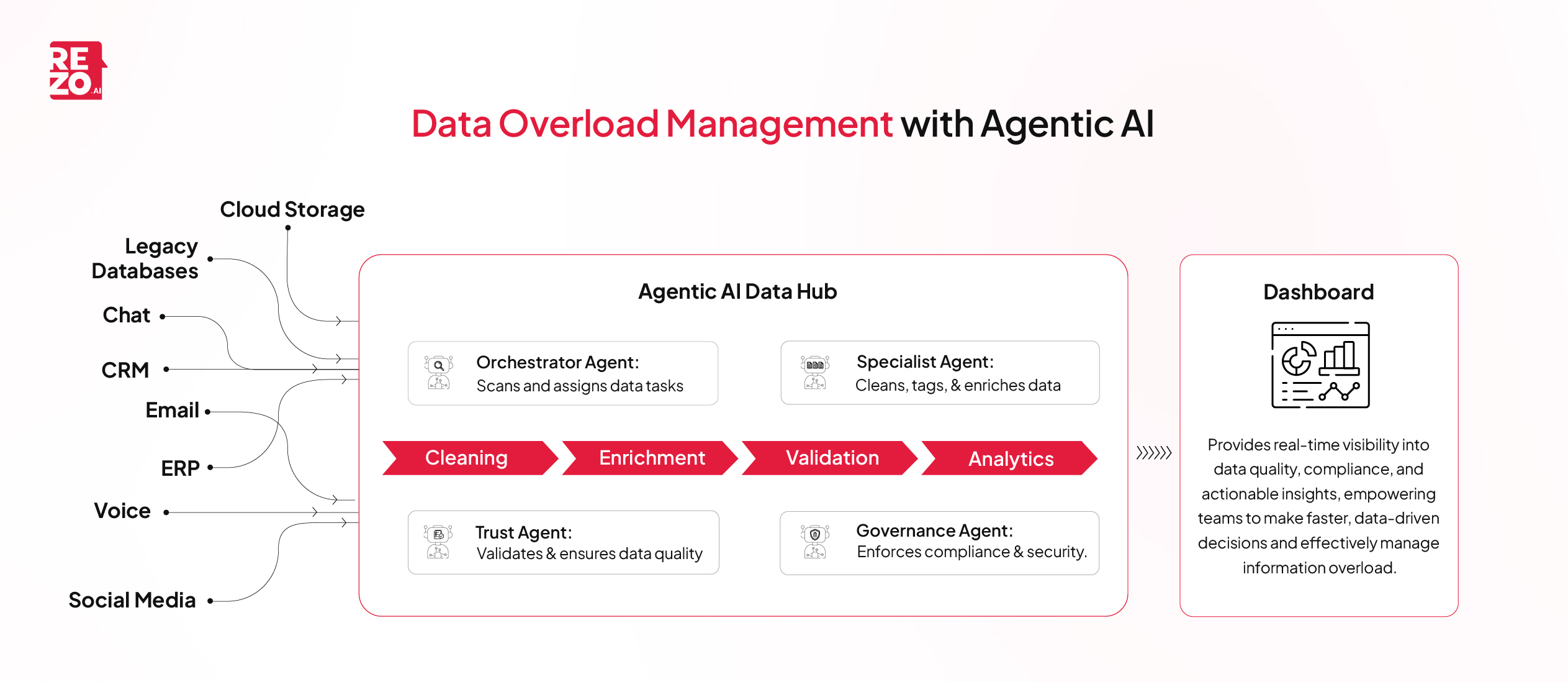
What makes agentic AI especially powerful is its ability to learn and prioritize on its own. For example, an Orchestrator Agent dynamically routes streaming data to optimized processing pipelines, while a Trust Agent enforces compliance and data integrity across hybrid environments. Crucially, agentic AI applies reinforcement learning to continuously refine data relevance thresholds filtering out more than 70% of low-value noise while surfacing anomalies, trends, and customer intent signals that demand action.
The technical implementation leverages three core innovations:
- Unified Data Fabric: AI agents auto-discover and map data relationships across silos (ERP, CRM, data lakes) into real-time customer graphs, using vector embeddings for instant cross-referencing.
- Intent-Driven Triage: NLP-powered agents classify data by business impact, routing critical alerts (e.g., churn signals, SLA breaches) to CX teams while autonomously resolving routine issues like schema mismatches.
- Self-Optimizing Infrastructure: Agents monitor query patterns and resource utilization, auto-scaling cloud resources and rewriting inefficient SQL reducing data processing costs by 40% while accelerating insights delivery to sub-second latency.
For CX leaders, this eliminates the "analysis paralysis" bottleneck. Teams shift from reactive firefighting to proactive strategy, with AI agents delivering curated insights like:
- Real-time customer sentiment shifts during support interactions
- Predictive churn triggers based on behavioral micro-patterns
- Dynamic resource allocation for high-priority queues
By transforming data overload into automated, actionable intelligence, agentic AI turns CX data from a liability into a competitive accelerator.
Technical Hurdles to Achieving True Omnichannel Consistency
Delivering a seamless, context-aware customer experience across all customer touchpoints like voice, chat, email, social, and in-store remains a technical challenge for enterprises. Legacy systems operate in silos, each with their own data schemas, protocols and state management frameworks. This fragmentation means customers have to repeat information when switching between multiple channels, gets inconsistent responses and fractures the entire customer journey. Traditional middleware or API-led integrations only partially solve the problem as they lack real-time contextual awareness and autonomous decision making capabilities for a customer experience strategy.
Agentic AI systems rethink omnichannel consistency through a multi-agent architecture. Each AI agent is a node in a decentralized network, sharing a unified context layer via a real-time vector database (e.g. Redis, Pinecone). This layer ingests and normalizes data from all sources—CRM, POS, IoT sensors, social media—into structured embeddings that include purchase history and previous customer interactions. When a customer initiates an interaction, an Orchestrator Agent assigns the query to the optimal channel-specific agent (e.g. IVR, chatbot) while preserving session state. Crucially agents update this shared context after each interaction so subsequent touchpoints can inherit full conversational history and intent without manual handoffs, so the customer experience is consistent across the entire customer journey.
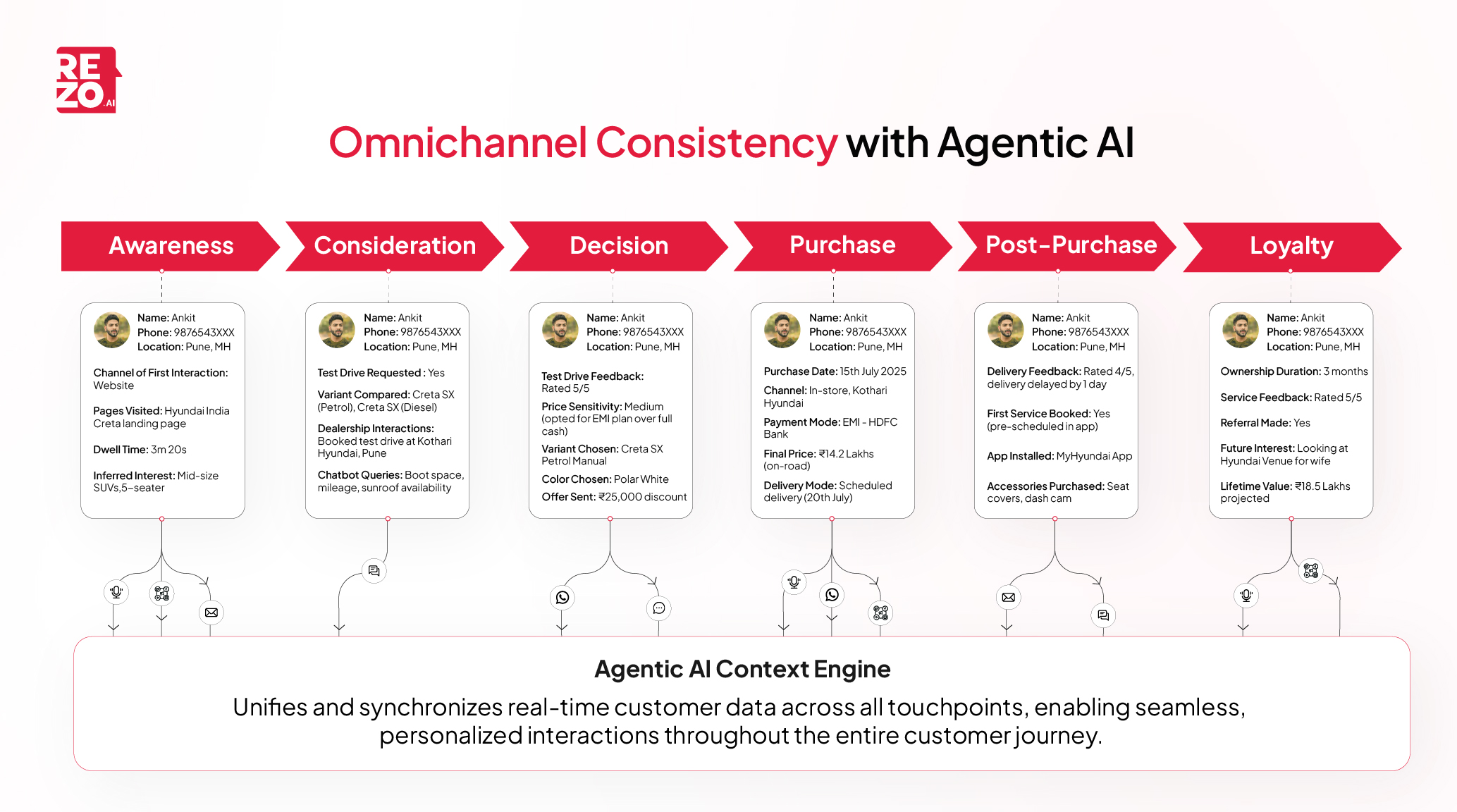
The results go beyond traditional metrics:
- Customer graphs unify all customer interactions into a single timeline, eliminating channel-specific data silos and giving a 360 degree view of the customer experience.
- Agents anticipate channel switches—e.g. escalating a social media complaint to a voice callback with full context, including purchase history, prepopulated in the agent’s UI—reducing customer churn.
- Customers never have to re-identify themselves or restate their issue, cutting average handle time by 30% and improving overall customer experience.
For CX leaders, agentic AI systems make omnichannel a reality not an aspiration. It eliminates the technical debt of point-to-point integrations and delivers measurable consistency, proven by brands achieving 90+ NPS scores across 8+ channels. The architecture scales elastically, handling 10,000+ concurrent journeys with sub-second latency, so inconsistent customer experiences and unnecessary customer churn are a thing of the past. This is the foundation for a future-proof customer experience strategy.
Moving Towards Proactive Support
Most companies still rely on reactive support, waiting for customers to hit a problem and reach out for help. This is limited as it often leads to bad customer experience and breaks the brand promise. By the time a customer complains the damage to customer satisfaction and loyalty is already done which can impact overall business performance and net promoter score. Reactive support is also resource intensive as teams scramble to fix issues that could have been prevented with better foresight. The core challenge is that traditional systems can’t synthesise signals from across channels and data sources in real time so it’s impossible to spot early warning signs or intervene before issues escalate.
Proactive support is about anticipating customer needs and resolving potential problems before they impact the customer experience. It requires the ability to monitor vast streams of operational, behavioural and sentiment data, identify emerging risks and trigger timely, personalised interventions. Until recently this level of sophistication was out of reach for most organisations as it demanded not only advanced analytics but also the ability to act on insights in real time and at scale.
Agentic AI, powered by large language models and generative AI, changes the game by deploying autonomous agents that operate across data sources, channels and touchpoints. These AI agents can ingest and analyse real time data from CRM systems, product usage logs, support interactions and even social media. By using advanced machine learning agentic AI can detect subtle patterns – a sudden drop in app engagement, repeated transaction errors or negative shifts in customer sentiment – that often precede support requests or customer churn. When these signals are detected the AI can take immediate, context aware actions: send a personalised notification, offer a solution, escalate complex tasks to a human agent or even resolve the issue autonomously.
What sets agentic AI apart is it can learn and adapt with every interaction. These AI agents learn continuously, refining their understanding of what signals matter most for each customer segment and scenario, reducing false alarms and ensuring interventions are timely and relevant. For CX leaders this means shifting from a firefighting mode to a preventative, customer centric approach. The result is a dramatic reduction in support ticket volumes, faster resolution times and higher customer satisfaction – turning support from a cost centre into a strategic driver of business outcomes and better business performance.
Solve for Agent Burnout and Declining Efficiency
Agent burnout is a growing concern for CX leaders, especially as customer expectations rise and support channels multiply. Call center agents today face relentless queues, emotionally charged conversations, and a constant pressure to resolve issues quickly all of which contribute to chronic stress, exhaustion, and high turnover rates. The problem is compounded by repetitive tasks, unclear expectations, and uneven workload distribution, making it difficult for agents to stay motivated and productive over the long term.
Traditional approaches to managing burnout like training, wellness programmes, or manual workload balancing offer only limited relief. The real breakthrough comes with the adoption of agentic AI. Unlike basic automation or static AI tools, agentic AI deploys autonomous software agents capable of handling a wide range of repetitive and routine tasks, such as data entry, call summarisation, and basic troubleshooting. This frees human agents to focus on more complex, emotionally nuanced interactions that require empathy and problem-solving, which not only reduces cognitive fatigue but also increases job satisfaction.
Agentic AI also brings intelligence to workload management. By analysing real-time data on call volumes, agent performance, and customer sentiment, AI agents can dynamically distribute tasks, reroute high-stress cases, and adjust schedules to prevent any one agent from being overwhelmed. For example, if an agent is handling a series of difficult calls, the system can automatically assign them lower-stress tasks or provide suggested responses to help them recover. Predictive analytics further enables managers to anticipate peak periods and staff accordingly, reducing the risk of burnout before it occurs.
Continuous learning is another advantage. Agentic AI systems learn from each interaction, improving their ability to support agents with relevant information, automate after-call work, and even suggest the best ways to handle complex queries in real time. This not only boosts efficiency but also ensures that agents are better equipped and less burdened by routine or repetitive work.
For CX leaders, the shift to agentic AI means a more resilient, efficient, and satisfied workforce. By automating low-value tasks, intelligently managing workloads, and supporting agents with real-time insights, agentic AI addresses the root causes of burnout and enables agents to deliver consistently high-quality customer experiences without sacrificing their own wellbeing.
Final Thoughts
Agentic AI marks a decisive turning point for customer experience leadership. It is not merely an incremental improvement, but a foundational shift that redefines what is possible in customer engagement, operational agility, and workforce empowerment. The organisations that act now adopting agentic AI as a core pillar of their CX strategy will set the pace for their industries, outpacing competitors who remain tied to legacy thinking and static automation. In an era where customer expectations are evolving faster than ever, agentic AI is the catalyst that enables enterprises to deliver proactive, hyper-personalised, and truly seamless experiences at scale. The future of CX belongs to those bold enough to lead this transformation.
Frequently Asked Questions
How is agentic AI different from traditional AI or automation in CX?
Agentic AI operates with autonomy and context-awareness, making decisions and taking actions in real time, unlike traditional AI which typically follows static rules or scripts. This allows agentic AI to adapt to dynamic customer needs and orchestrate complex workflows without constant human intervention.
Is it difficult to integrate agentic AI with our existing legacy systems?
No, one of the key strengths of agentic AI is its ability to bridge legacy and modern systems. It can generate APIs, translate protocols, and unify data from disparate sources, making integration far less disruptive and more cost-effective than traditional system overhauls.
What is the first step for a CX leader to adopt agentic AI?
Start by identifying the most pressing pain points in your current CX processes such as data silos, inconsistent experiences, or high agent workload. Then, pilot agentic AI in one or two high-impact areas to demonstrate quick wins and build momentum for broader adoption across the organisation.
Frequently Asked Questions (FAQs)

Take the leap towards innovation with Rezo.ai
Get started now









